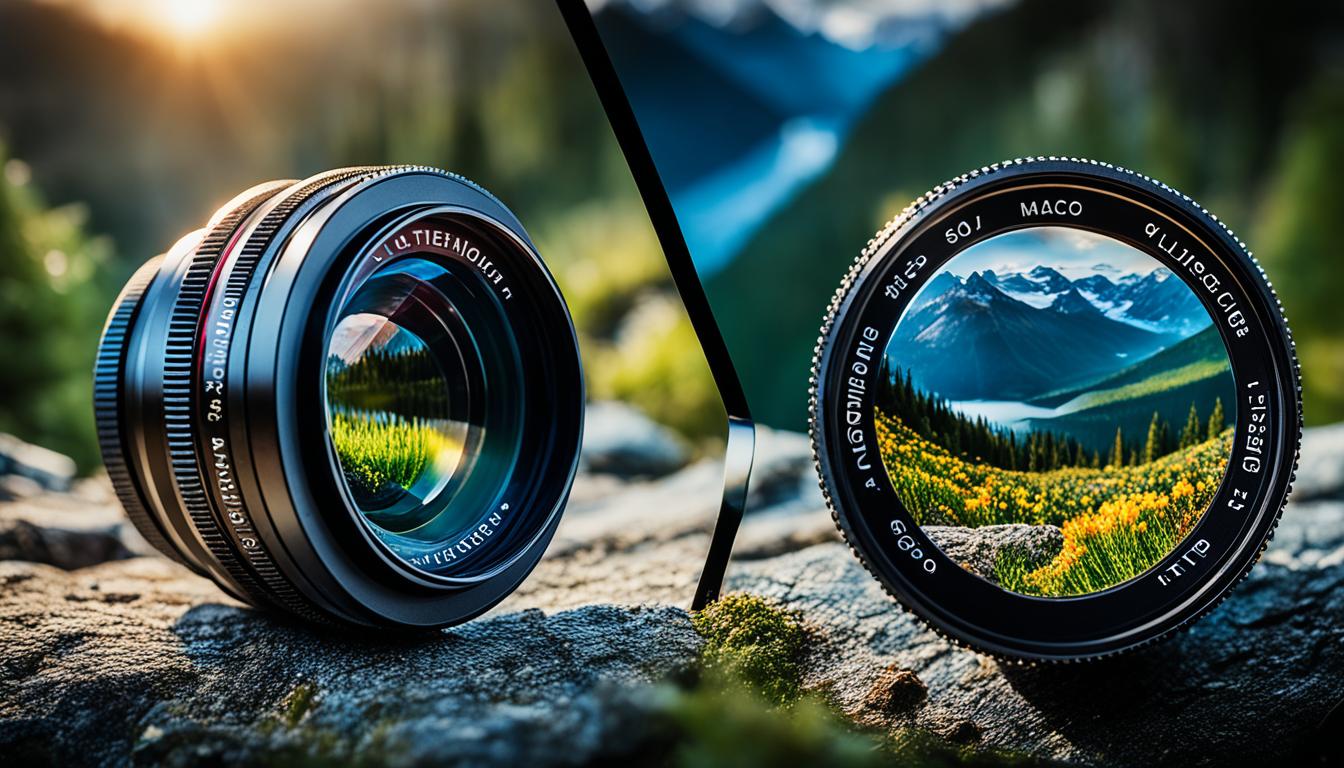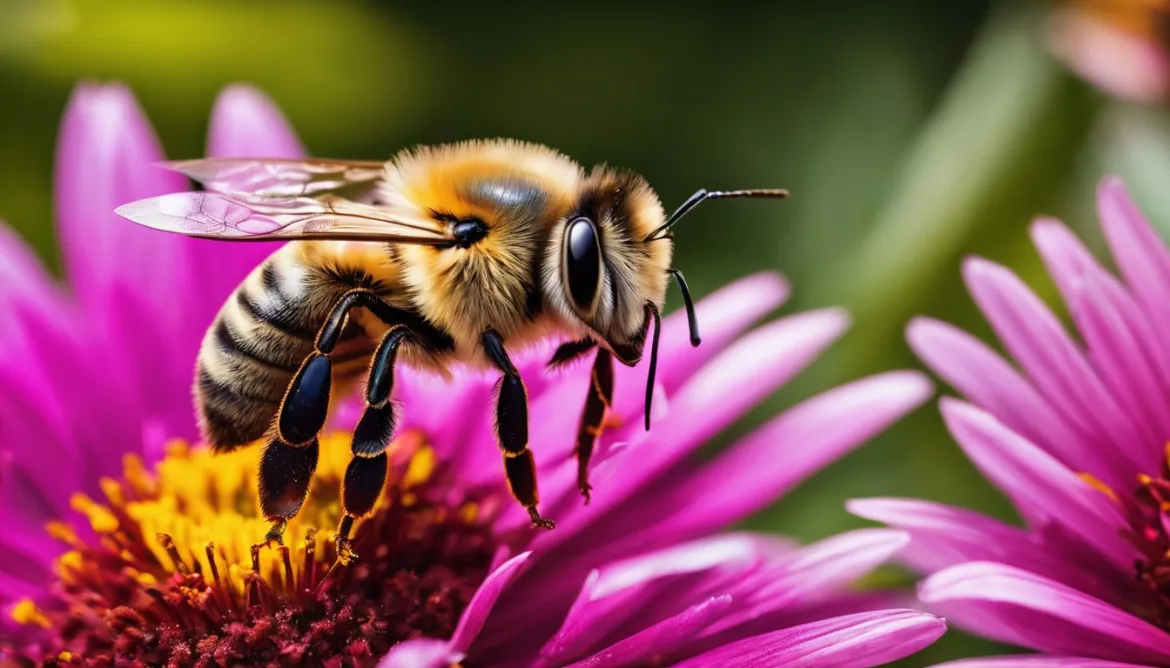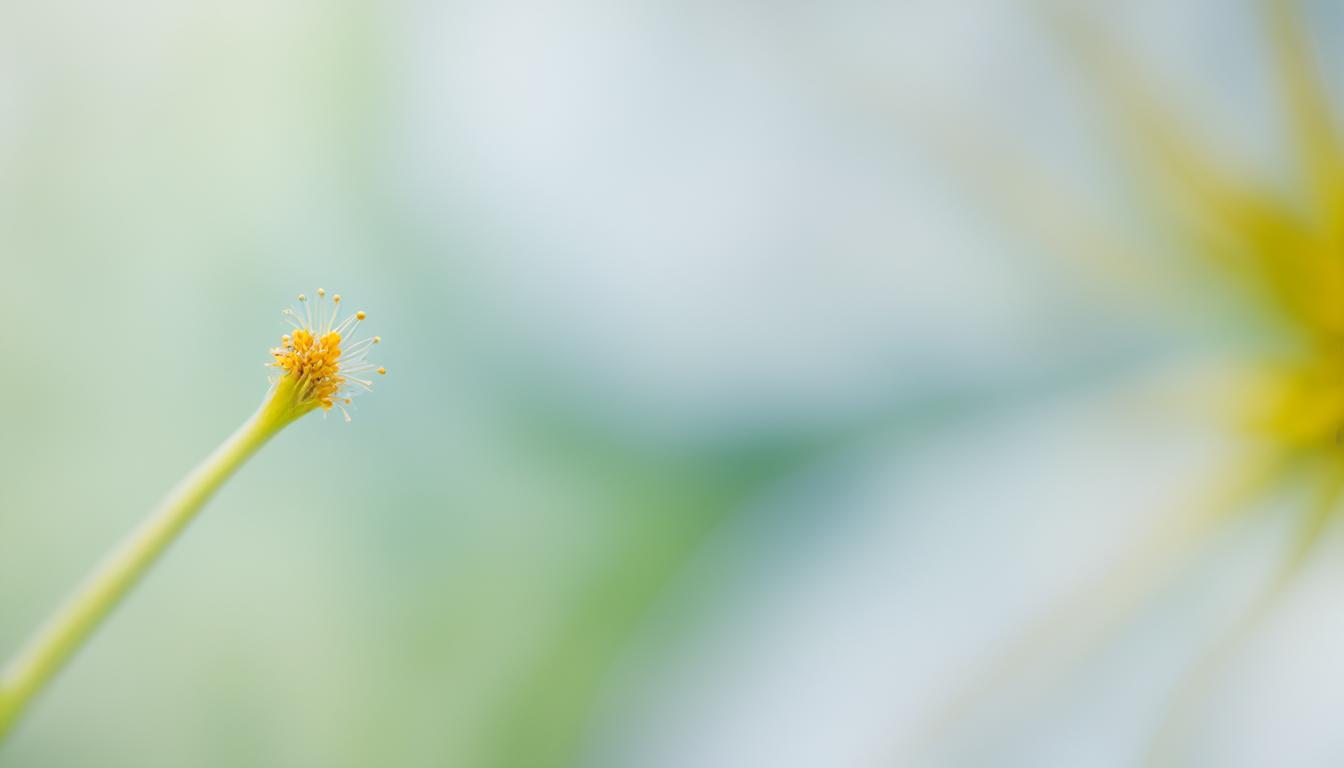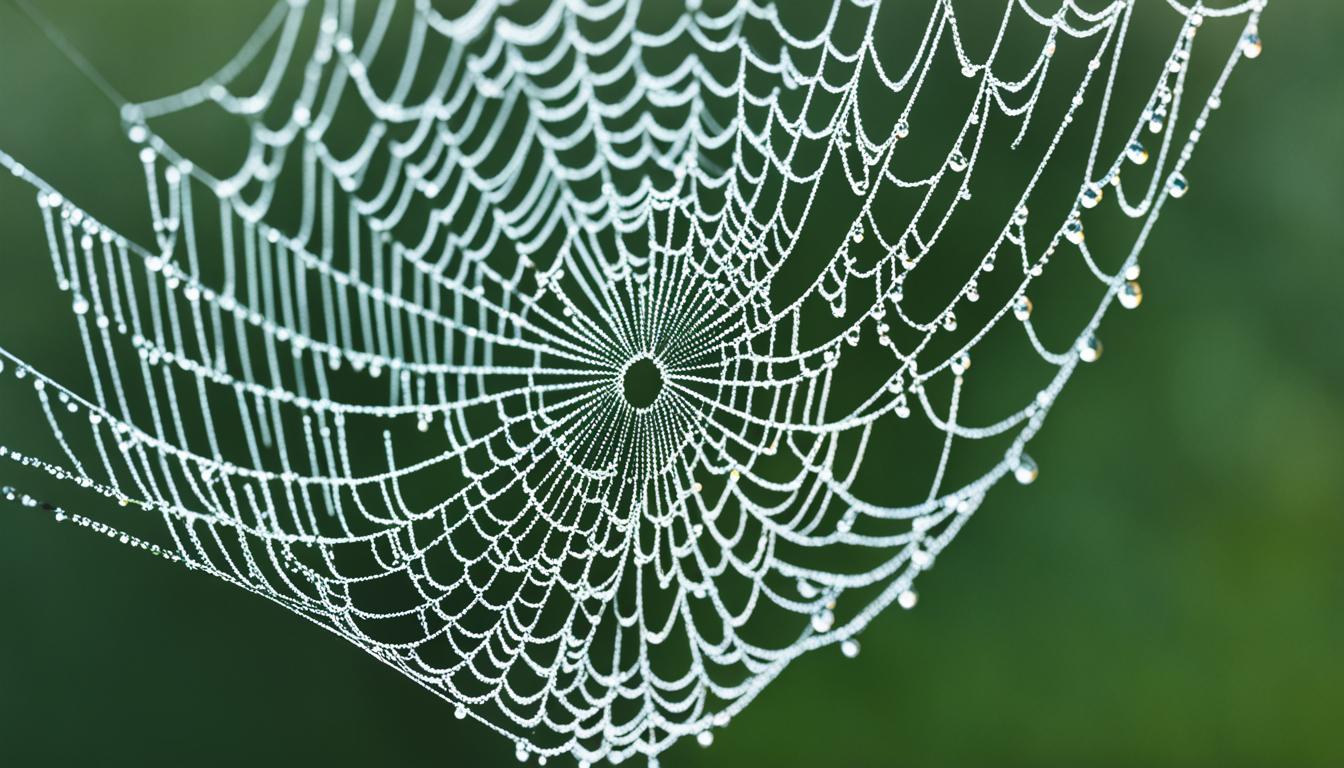Choosing the right lens for macro photography can be a daunting task, with so many options available. But fear not! In this comprehensive guide, we will provide you with all the information you need to make an informed decision and select the best lens for your macro photography needs. From understanding the key features to exploring different focal lengths and aperture settings, we’ve got you covered. Whether you’re a professional photographer or a hobbyist, this guide will help you capture stunning macro shots with incredible detail.
Key Takeaways:
- Choosing the right lens is crucial for successful macro photography.
- Consider factors such as focal length, aperture, and magnification when selecting a macro lens.
- Canon and Nikon offer excellent macro lens options with different strengths and capabilities.
- Understanding macro photography techniques and using accessories can enhance your macro shooting experience.
- Follow tips for achieving sharp and captivating macro images.
What is a Macro Lens?
A macro lens is a specialized lens designed for close-up photography. It allows us to capture small subjects, such as insects, flowers, or textures, and magnify them to life-size on our camera’s sensor. Macro lenses offer excellent sharpness, color reproduction, and contrast, making them ideal for capturing intricate details. They can also be used for portrait photography, as they produce sharp images with beautiful bokeh.
In close-up photography, a macro lens is essential for capturing stunning images with incredible detail. Whether you’re a professional photographer or an amateur enthusiast, having a macro lens in your camera bag opens up a whole new world of creative possibilities.
Function of a Macro Lens
A macro lens serves the primary function of allowing photographers to focus on subjects at very close distances. Instead of relying on digital zoom or cropping the image later, a macro lens enables us to capture intimate details without compromising image quality or sharpness. It achieves this through its unique optical design, which achieves a high level of magnification while maintaining optimum image quality.
Macro lenses are specifically designed to produce images with minimal distortion and high resolution, ensuring that the subjects appear lifelike and true to their actual size. This level of precision and accuracy is especially important when photographing small objects or intricate textures where every detail matters.
Benefits of a Macro Lens
Using a macro lens offers several advantages over other lenses when it comes to close-up photography:
- Greater magnification: Macro lenses allow us to capture subjects at a 1:1 or even higher magnification ratio, bringing out the finest details and textures in our images.
- Sharper images: Macro lenses are designed to provide excellent image sharpness, ensuring that every detail is crisp and clear.
- Close focusing distance: Macro lenses have a shorter minimum focus distance compared to other lenses, allowing us to get closer to our subjects.
- Superior image quality: With their advanced optical elements and coatings, macro lenses deliver exceptional color reproduction, contrast, and clarity.
- Wide aperture options: Many macro lenses offer wide maximum aperture settings, allowing for creative depth-of-field control and beautiful background blur.
A macro lens is a versatile tool that goes beyond just capturing small subjects. It can also be used for other types of photography, such as product photography, where fine details and textures are important. Additionally, the shallow depth of field achieved with macro lenses can create stunning bokeh and isolate the subject from the background, making them suitable for portrait photography.
Do I Need a Macro Lens?
Deciding whether you need a macro lens depends on your photography needs and interests. If you are interested in capturing small objects, animals, insects, plants, or textures in great detail, a macro lens is essential. It is also useful for pet photography, wedding and event photography, newborn photography, product photography, and portraits. However, if you only occasionally need macro shots and already have a telephoto lens, you may consider other options. In this section, we will help you determine if a macro lens is the right choice for you.

When it comes to capturing intricate details and exploring the beauty of the small world, a macro lens unlocks new creative possibilities. With its close-up capabilities, a macro lens offers unparalleled precision in capturing the finest details of your chosen subject. Whether you are a professional photographer or an enthusiast, investing in a macro lens can take your photography to the next level.
When to Use a Macro Lens
Here are some situations where using a macro lens can greatly enhance your photography:
- Capturing the delicate features of flowers or plants in macro photography
- Focusing on the intricate patterns and textures of objects
- Photographing insects and other small creatures with exceptional detail
- Documenting the finer intricacies of jewelry or product photography
- Creating striking close-up portraits with a unique perspective
These situations call for the specialized capabilities of a macro lens, allowing you to explore and capture the world around you in a whole new way.
Considering Alternatives
If you are unsure about investing in a dedicated macro lens, there are alternative options to consider:
- Telephoto lens with macro capabilities: Some telephoto lenses offer a macro mode, allowing you to achieve a closer focus and capture small subjects. While they may not offer the same level of magnification as dedicated macro lenses, they can be a good option if you already have a telephoto lens in your kit.
- Macro filters: These are screw-on filters that attach to the front of your existing lens, effectively turning it into a macro lens. While they can be a cost-effective solution, they may not deliver the same level of image quality and sharpness as dedicated macro lenses.
Ultimately, the decision to invest in a macro lens depends on your specific needs and budget. If you are passionate about macro photography and are looking for the highest level of detail and quality, a dedicated macro lens is highly recommended.
Key Features to Look for in a Macro Lens
When it comes to choosing a macro lens, there are several key features that should be taken into consideration. These features play a crucial role in determining the performance and versatility of the lens for capturing stunning macro shots. Let’s explore the essential features to look for:
Focal Length
The macro lens focal length is an important factor to consider. Longer focal lengths, typically around 100mm, offer greater working distance and flexibility. They allow you to maintain a comfortable distance from your subject while still capturing intricate details. Shorter focal lengths, such as 50mm, are more suitable for close-up shots where you have direct access to the subject.
Aperture
The macro lens aperture setting is another critical feature. Macro photography often requires narrow apertures to achieve sufficient depth of field and ensure that the entire subject is in focus. A wider range of aperture settings provides greater creative control over the background blur, or bokeh, in your macro images.
Magnification
The macro lens magnification ratio determines how closely you can capture your subject. A 1:1 magnification ratio is considered the minimum for true macro photography. This means that the subject is reproduced on the camera sensor at life-size, allowing for incredibly detailed close-up shots. Some macro lenses offer even higher magnification ratios, such as 1:2 or 2:1, for capturing extremely small subjects.
Autofocus
Autofocus capabilities are essential for convenience and precision in macro photography. Look for a macro lens with reliable autofocus performance, allowing you to quickly and accurately lock focus on your subject. Some lenses also offer manual focus override for fine-tuning focus when needed.
Image Stabilization
Image stabilization can greatly enhance the sharpness of your macro shots, especially when shooting handheld or in low-light conditions. A macro lens with image stabilization compensates for camera shake, resulting in clearer and sharper images. This feature becomes particularly important when using longer focal lengths where even slight movements can affect image quality.
| Feature | Importance | Example Lens |
|---|---|---|
| Focal Length | High | Canon EF 100mm f/2.8L Macro IS USM |
| Aperture | High | Nikon AF-S VR Micro-Nikkor 105mm f/2.8G IF-ED |
| Magnification | High | Sigma 150mm f/2.8 EX DG OS HSM Macro |
| Autofocus | Medium | Tamron SP 90mm f/2.8 Di VC USD Macro |
| Image Stabilization | Medium | Sony FE 90mm f/2.8 Macro G OSS |
“When choosing a macro lens, consider the focal length, aperture, magnification, autofocus, and image stabilization. These features will ensure that you have the necessary tools to capture stunning macro photographs with intricate detail and sharpness.”
By carefully evaluating these key features, you can select a macro lens that meets your specific needs and helps you achieve outstanding results in macro photography.
Best Macro Lenses for Canon
Canon offers a range of exceptional macro lenses that are perfect for photographers looking to capture stunning close-up shots with incredible detail. Whether you’re a professional or a hobbyist, these lenses provide exceptional image quality, sharpness, and versatility for all your macro photography needs.
One standout option is the Canon MP-E 65mm f/2.8 1-5X lens. With its impressive magnification range of up to 5:1, this lens is ideal for shooting very small objects, allowing you to capture intricate details that are otherwise unseen.
Another top choice is the Canon EF 100mm f/2.8 L Macro IS USM lens. This lens offers excellent image stabilization and delivers stunning results, making it a favorite among macro photographers.
The Canon EF 180mm f/2.5L Macro USM lens is another outstanding option. With its longer focal length, this lens provides greater working distance and flexibility for capturing macro shots in various settings.
For those looking for a more affordable option, the Canon EF 100mm f/2.8 Macro USM lens is an excellent choice. It offers exceptional image quality and is a popular lens among photographers for its versatility and affordability.
Lastly, the Sigma 105mm f/2.8 EK DG OS HSM Macro lens is worth considering. This lens combines superb image quality with advanced optical image stabilization, allowing you to capture sharp macro images even in challenging shooting conditions.
Overall, Canon provides an impressive selection of macro lenses, each offering unique features and capabilities to suit your specific photography needs. These lenses are designed to deliver outstanding performance and help you bring your macro photography to the next level.

Comparison Table: Best Macro Lenses for Canon
| Lens | Magnification Ratio | Image Stabilization |
|---|---|---|
| Canon MP-E 65mm f/2.8 1-5X lens | Up to 5:1 | No |
| Canon EF 100mm f/2.8 L Macro IS USM lens | 1:1 | Yes |
| Canon EF 180mm f/2.5L Macro USM lens | 1:1 | No |
| Canon EF 100mm f/2.8 Macro USM lens | 1:1 | No |
| Sigma 105mm f/2.8 EK DG OS HSM Macro lens | 1:1 | Yes |
Best Macro Lenses for Nikon
Nikon photographers have a wide range of options when it comes to choosing the best macro lenses. These lenses are designed to capture intricate details and provide superb image quality. Whether you are a professional or an enthusiast, these top macro lenses for Nikon will enhance your macro photography experience.
The first lens on our list is the Nikon Micro-Nikkor 105mm f/2.8G VR lens. With a 1:1 magnification ratio and image stabilization, this lens offers excellent close-up capabilities and ensures sharp and steady shots. It is a popular choice among Nikon users for capturing small subjects with stunning detail.
Another notable lens is the Nikon AF-S VR Micro-Nikkor 105mm f/2.8G IF-ED lens. With its versatile focal length and advanced lens design, this lens delivers exceptional image quality and precise autofocus. It is ideal for macro photography and can also be used for portrait and general photography.
If you are looking for a more compact option, the Nikon AF-S DX Micro-Nikkor 85mm f/3.5G ED VR lens is worth considering. This lens is specifically designed for Nikon’s DX-format DSLRs and offers a 1:1 magnification ratio. It delivers impressive detail and sharpness, making it a great choice for close-up photography.
For those who prefer third-party lenses, the Sigma 105mm f/2.8 EX DG OS HSM Macro lens is an excellent option. With its high-quality optics and fast autofocus, this lens provides superior image quality and accurate focus. It is compatible with Nikon DSLRs and offers a 1:1 magnification ratio for stunning macro shots.
Whether you choose a Nikon-branded lens or a third-party option, these top macro lenses for Nikon will elevate your macro photography game. Their exceptional image quality, focus accuracy, and macro capabilities will allow you to capture stunning close-up shots with incredible detail.
Top Macro Lenses for Nikon
| Macro Lens | Magnification Ratio | Image Stabilization |
|---|---|---|
| Nikon Micro-Nikkor 105mm f/2.8G VR lens | 1:1 | Yes |
| Nikon AF-S VR Micro-Nikkor 105mm f/2.8G IF-ED lens | 1:1 | No |
| Nikon AF-S DX Micro-Nikkor 85mm f/3.5G ED VR lens | 1:1 | Yes |
| Sigma 105mm f/2.8 EX DG OS HSM Macro lens | 1:1 | No |
Other Considerations in Macro Photography
In addition to choosing the right macro lens, there are other important factors to consider when delving into macro photography. These considerations can enhance your macro shooting experience and help you capture stunning close-up images with incredible detail.
Macro Lens Accessories
Accessorizing your macro lens can greatly expand its capabilities and improve the quality of your macro shots. Some essential macro lens accessories include:
- Extension tubes: These tubes are placed between your camera body and lens, allowing you to get closer to your subject and achieve higher magnification.
- Close-up filters: These filters are similar to magnifying glasses that screw onto the front of your lens, enabling you to focus at much shorter distances.
- Tripods: A sturdy tripod is essential for macro photography as it helps eliminate camera shake, ensuring sharp and blur-free images.
By incorporating these accessories into your macro photography setup, you can unlock new creative possibilities and capture intricate details that might otherwise go unnoticed.
Macro Photography Techniques
Understanding and mastering different macro photography techniques can take your images to the next level. Here are a few techniques to consider:
- Focus stacking: This technique involves taking multiple images of the same subject at different focus distances and combining them in post-processing to achieve a greater depth of field.
- Lighting: Experimenting with different lighting setups, such as natural light, diffused light, or using external flashes, can dramatically impact the mood and quality of your macro images.
Exploring and implementing these techniques can help you capture even more visually stunning and captivating macro photographs.
Macro Lens Alternative Options
If investing in a dedicated macro lens is not currently feasible, there are alternative options available for exploring macro photography:
- Telephoto lens with macro capabilities: Some telephoto lenses have a close focusing distance and offer macro capabilities, providing a versatile solution for both telephoto and macro photography.
- Macro filters: These screw-on filters allow you to achieve a closer focusing distance with your existing lenses, effectively turning them into macro lenses.
While dedicated macro lenses often offer the best image quality and magnification ratios, these alternative options can be more budget-friendly and offer a way to experiment with macro photography until you are ready to invest in a dedicated macro lens.
Overall, considering these additional aspects, such as macro lens accessories, macro photography techniques, and alternative options, can broaden your creative possibilities and enhance your macro photography skills.
Tips for Macro Photography Success
To achieve success in macro photography, there are several tips and techniques that can greatly enhance your results. Whether you’re capturing the delicate details of a flower petal or the intriguing patterns on an insect’s wings, these macro photography tips will help you capture sharp and stunning images.
1. Use a Steady Support System
Capturing sharp macro images requires stability to minimize camera shake. Use a tripod or monopod to keep your camera steady, especially when shooting at small apertures or in low light conditions. This will ensure your images are crisp and free of blur.
2. Master Lighting Control
Lighting plays a crucial role in macro photography. Understanding and controlling your light source can make a significant difference in the final image. Experiment with natural light, diffusers, reflectors, and even artificial lighting setups to create the desired effect and highlight the intricate details of your subject.
3. Utilize Small Apertures
When shooting macro, using small apertures (higher f-numbers) is essential to achieve a greater depth of field. This helps ensure that your entire subject is in sharp focus, even when capturing intricate details. Experiment with different apertures to find the perfect balance between sharpness and depth of field.
4. Adjust Your Composition
Composition is crucial in macro photography. Pay attention to the placement and positioning of your subject within the frame to create visually appealing images. Experiment with different angles, perspectives, and framing techniques to highlight the unique features and details of your subject.
With these tips in mind, you’ll be well on your way to capturing stunning macro images with incredible sharpness and detail. Keep practicing, experimenting, and refining your technique to develop your own unique style in the fascinating world of macro photography.
Conclusion
After exploring the world of macro lenses, we now have a clearer understanding of what to look for when choosing the best lens for macro photography. Focal length, aperture, magnification, autofocus, and image stabilization are all important factors to consider. Canon and Nikon offer a range of exceptional macro lens options, each with its own strengths and capabilities.
By delving into the unique features and considerations of macro lenses, we can capture stunning close-up shots with incredible detail. It’s also worth considering alternative options and accessories, such as using extension tubes or close-up filters, to enhance your macro photography experience.
With the tips and techniques we have explored in this guide, you can elevate your macro photography skills and achieve breathtaking results. Remember to use a steady support system, control your lighting, and adjust your composition to highlight your subject. With the right lens and these key takeaways, you’ll be well-equipped to capture the captivating world of macro photography.
FAQ
What is a macro lens?
A macro lens is a specialized lens designed for close-up photography. It allows you to capture small subjects with great detail and magnify them to life-size on your camera’s sensor. Macro lenses offer excellent sharpness, color reproduction, and contrast.
Do I need a macro lens?
Whether you need a macro lens depends on your photography needs and interests. If you are interested in capturing small objects, animals, insects, plants, or textures in great detail, a macro lens is essential. It is also useful for various photography genres such as pet, wedding and event, newborn, product, and portrait photography.
What key features should I look for in a macro lens?
When choosing a macro lens, consider the focal length, aperture, magnification ratio, autofocus, and image stabilization. Longer focal lengths (around 100mm) provide more working distance and flexibility. Narrower apertures are often required for sufficient depth of field. A 1:1 magnification ratio is the minimum for true macro lenses. Autofocus and image stabilization are additional features to consider.
What are the best macro lenses for Canon?
Some of the top macro lenses for Canon include the Canon MP-E 65mm f/2.8 1-5X lens, Canon EF 100mm f/2.8 L Macro IS USM lens, Canon EF 180mm f/2.5L Macro USM lens, Canon EF 100mm f/2.8 Macro USM lens, and Sigma 105mm f/2.8 EK DG OS HSM Macro lens. These lenses offer exceptional image quality, sharpness, and versatility for macro photography.
What are the best macro lenses for Nikon?
Some of the top macro lenses for Nikon include the Nikon Micro-Nikkor 105mm f/2.8G VR lens, Nikon AF-S VR Micro-Nikkor 105mm f/2.8G IF-ED lens, Nikon AF-S DX Micro-Nikkor 85mm f/3.5G ED VR lens, and Sigma 105mm f/2.8 EX DG OS HSM Macro lens. These lenses provide superb image quality, focus accuracy, and macro capabilities for Nikon photographers.
What other considerations are there in macro photography?
Besides choosing the right macro lens, you can enhance your macro photography with accessories such as extension tubes, close-up filters, and tripods. Understanding macro photography techniques like focus stacking and lighting can also improve your results. If investing in a dedicated macro lens isn’t feasible, you can explore alternative options like using a telephoto lens with macro capabilities or using macro filters.
What are some tips for macro photography success?
Using a steady support system like a tripod or monopod can help minimize camera shake and capture sharp images. Controlling your lighting, whether natural or artificial, is crucial for achieving the desired effect. Using small apertures for greater depth of field and adjusting your composition to highlight the subject are also key considerations.
What should I consider when choosing a macro lens?
When choosing a macro lens, consider factors such as focal length, aperture, magnification ratio, autofocus, and image stabilization. Canon and Nikon offer excellent macro lens options, each with their own strengths and capabilities. Understanding the unique features and considerations of macro lenses, as well as exploring alternative options and accessories, can help you make an informed decision.
What are the key takeaways from this macro lens guide?
Choosing the best lens for macro photography requires careful consideration of various factors. Macro lenses are essential for capturing small subjects with great detail, but alternative options and accessories can also enhance your macro photography. Understanding macro photography techniques and following tips for success will help you capture stunning close-up shots with incredible detail.
How Do Extension Tubes and Close-Up Filters Compare to Dedicated Macro Lenses for Photography?
When comparing extension tubes closeup filters to dedicated macro lenses for photography, it’s important to consider factors like image quality, convenience, and cost. Extension tubes and close-up filters are budget-friendly options, providing versatility, while dedicated macro lenses offer superior image quality and performance for professional photographers.




